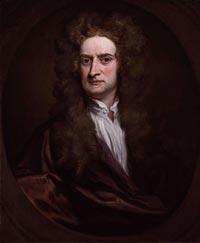
| Born: Dec 25, 1642 in Woolsthorpe-by-Colsterworth, Lincolnshire, England |
| Died: Mar 20, 1727 (at age 84) in Kensington, Middlesex, England, Great Britain |
| Nationality: English (later British) |
| Famous For: Newtonian mechanics, Principia Newton’s method, Universal gravitation, Optics Binomial series, Infinitesimal calculus |
Isaac Newton is considered one of the greatest scientists and physicists who ever lived. Newton invented a new kind of mathematics called calculus, discovered how light and color work and showed how gravity functions in the universe. Remarkably, he made these discoveries over a period of 18 months, between 1665 and 1667.
Early Life and Education
Isaac Newton was born in Woolsthorpe, England on December 25th, 1642. He went to Grantham grammar school, but he was more interested in making mechanical models than he was in studying and was considered a poor student. His boyish hobbies led to a small windmill that could grind corn and wheat, a water clock and a sundial. Newton left school when he was 14 because his widowed mother needed him to help with their farm. He was no better at this than he was at being a schoolboy and he was eventually sent back to school.
Newton entered Trinity College at Cambridge University in 1661. Here again he was a mediocre student. He left school in 1665 without distinction, but returned in 1667 as a fellow. In 1669 he became professor of mathematics and gave lectures on geometry, astronomy, optics and mathematics. He later quit and went to work for the government and was made a fellow of the Royal Society in 1672.
Discoveries
Newton claimed that he began to think about a theory of gravity while he was drinking tea one afternoon and saw an apple fall from a tree. This made him realize that the same force that made the apple fall is what keeps the moon in its orbit. He extrapolated from this to realize that gravity makes every pair of bodies in the universe attracted each other. He also learned that the strength of gravity depends on the amount of matter in the bodies being attracted and the distance between the bodies.
Newton also showed why the apple might fall straight to earth while the moon moved in a circle around the earth. He showed that the moon was falling constantly toward the earth and if it moved in a straight line, it would fly out of its orbit.
In 1684, Edmund Halley, the English astronomer, urged Newton to publish his findings on gravity. In 1687 Newton’s discoveries were published in Philosophiae Naturalis Principia Mathematica. Even today this book is considered one of the great scientific books of all time.
In 1704, Newton published Optiks. In this book, he explained why bodies appear to be colored. This laid the foundation for spectrum analysis, which allows scientists to determine the temperature, chemical composition and speed of bodies like distant stars. Newton also discovered that sunlight is a mix of light of all colors while passing sunlight through a prism.
Character
Interestingly, Newton did not spend too much time studying math, physics or astronomy. He was fascinated by alchemy and theology, and was so sensitive to criticism that he had to be urged by his friends to even publish his work. Yet, Albert Einstein claimed that he could not have done what he did without Newton’s discoveries.